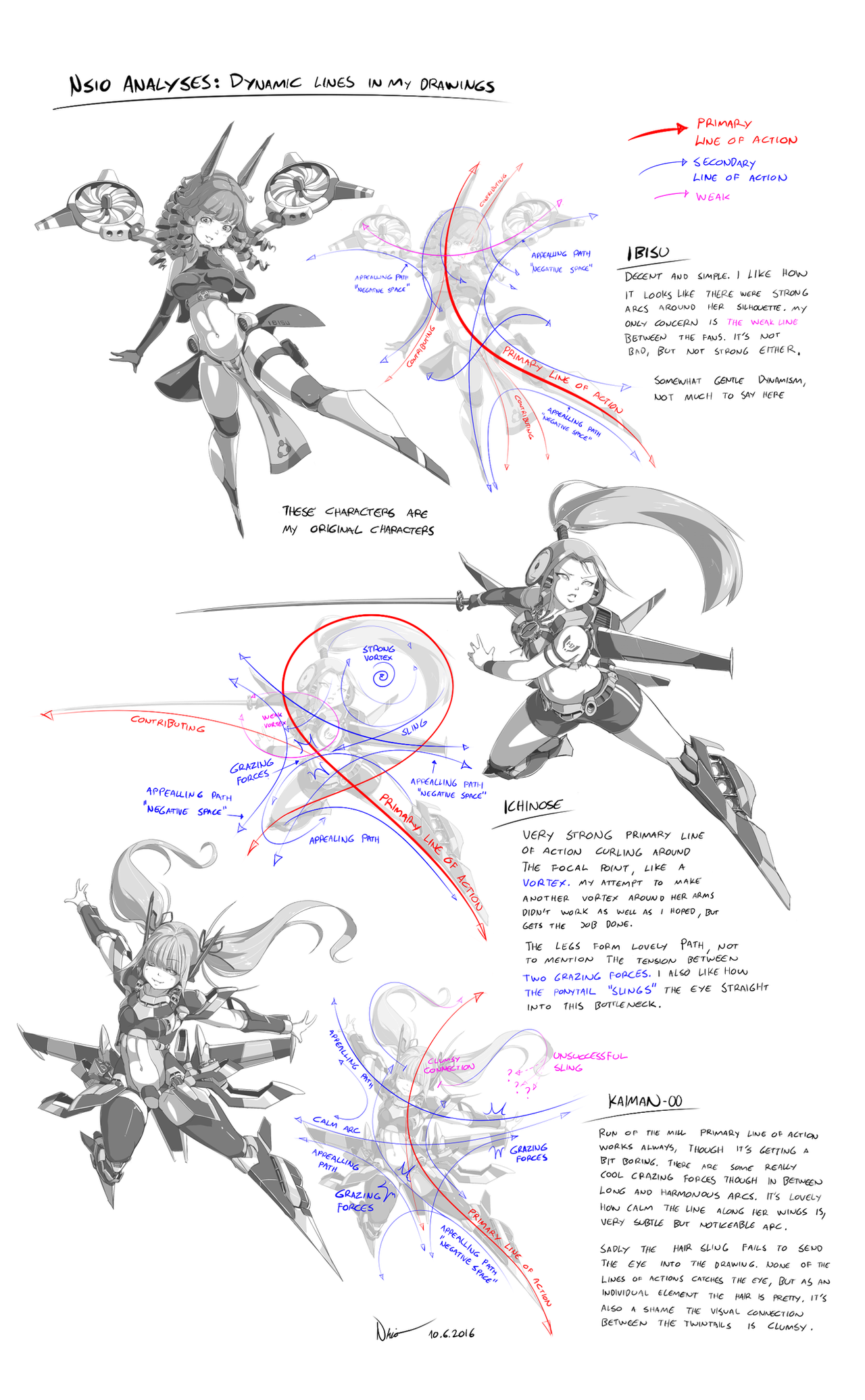HOME | DD
 Nsio — Nsio Analyses: Dynamic lines in my drawings
Nsio — Nsio Analyses: Dynamic lines in my drawings

#action #dynamism #line #tutorial #lineofaction #nsio
Published: 2016-06-09 21:59:48 +0000 UTC; Views: 57632; Favourites: 1033; Downloads: 1095
Redirect to original
Description
I thought doing some analyses on dynamism in my drawings. For now I analysed only three of my drawings which have many strong merits on this department. There are some others, but these will do for now. I may do some more analyses if people find them useful. The examples are my original characters, you can find direct links to the works from the bottom.This is how I see the dynamism in my eyes. The red line represents primary line of action, the main idea of the drawing. Blue lines are secondary line of actions that keep the elements in harmony. The lines drawn in magenta show some weak attempts of dynamism, although they aren't especially bad per se.
Ibisu:
She has pretty gentle primary line of action, which actually works pretty well on her nature of hovering movement. In that sense the dynamism here is rather lovely and calm. Her loin cloth nicely contributes to the primary line, so does her right arm. I really like how there appears to be some strong arcs surrounding her. For example, if you ignore her left leg, it's easy to see Y letter in her silhouette. The arc going along her leg wings is extremely sophisticated in my opinion.
My only real concern here is the weak line going along her fans and face. It's not too bad, but the visual cues aren't especially strong to give an impression of line of action.
Ichinose:
I'm really satisfied how this turned out. The primary line of action is reaaaaally long because it makes a complete loop around the character. This allows very powerful manipulation of the beholders eyes, as if there was a vortex in the middle of the loop. There is a lesser vortex around her arms, but sadly the visual cues don't contribute to that very much. As individual elements, the arms work nicely regardless.
The great merit here is how the tip of the pony tail actually slings the eye forward. Even better is the fact that it slings the eyes right into major crazing point of different forceful lines. I like the tension between the forces as they craze each other.
The forms on her legs have very appealing path for the eye to follow. I really like how the wing on her right leg has this subtle arc at the tip, which causes a logical path towards the tip of her left leg wing. A strong and solid character drawing all around in my opinion.
Kaiman-00
Again rather generic run of the mill primary line of action, but it works always. It can get rather boring after a while though.
There are some nice points for crazing forces here, namely around her crotch. I also like how there is this very calm line of action with subtle arc going along her wings. Had it been a straight line, the whole drawing would have been ruined. Definitely worth noting.
The hair is really pretty, but sadly the visual connection between the twintails suffers from clunky execution. They don't really form appealing path for the eyes like many other parts. Also, there is an unsuccessful attempt of sling, because there are no supporting line of actions aligned for the slingshot.
(I forgot to accentuate some keywords on Kaiman's analysis, but I'm too lazy to fix it






 )
)Here are the original character sheets:
Related content
Comments: 32

Again, really appreciate you taking the time to make stuff like this for others to use!
👍: 0 ⏩: 0

thank you so much for sharing!!! very interesting!!
👍: 0 ⏩: 0

i ... didn't.... understand...... a....... thing!!
👍: 0 ⏩: 0

Thanks for the awesome post, very educational.
If you don't mind me asking, do you have any tips for applying line of action and dynamism to less "active" and more vertical poses? I tend to have a more difficult time avoiding stiffness with more restrained standing/walking/sitting gestures but I've definitely seen character and reference sheets done by animators who have injected wonderful fluidity to static poses so I know it's possible!
👍: 0 ⏩: 1

Applying line of action on static/resting poses is just like on action poses, just more calm and subtle. With standing pose for example, it's good to pose the character so that the weight is on either of the legs, resulting a pose similar to Michelangelo's David statue: www.vam.ac.uk/__data/assets/im…
You can see how the lines on pelvis and shoulders are diagonal in opposite directions. That will make the characters back arc slightly. So even though David is standing still, there is very prominent dynamic line going trough his body.
(There are many other standing poses of course, but that's just one example.)
To further emphasize the line of action, you need secondary line of actions. They mostly reside on the body forms like muscles, or they can be seen to connect individual body parts into natural continuum. Arms, legs and hair, for example, are often drawn with secondary line of action in mind.
And of course, when you draw any pose, you need to capture the feel of the pose. If someone is resting, you need to make it look and behave like that (not really resting, but shows beautiful arc going along her back and arms: gilgonzalez.files.wordpress.co… ). If you want to show a strong character, you draw him in a posture that signify power (for example: vignette4.wikia.nocookie.net/m… ).
Sometimes you will need other elements than the actual pose to show the dynamism. Fluttering skirt or hair can be enough in some cases. Viewing angle can contribute a lot to the dynamism, not to mention the distortion caused by camera lens.
👍: 0 ⏩: 0

Damn! One day, I hope to be as good and as conscious about this stuff as you are. Very helpful tutorial!
👍: 0 ⏩: 1

It's for the best to aim even higher than that
👍: 0 ⏩: 0

Nsio you really are one of the best "Teachers" so to speak in art here in DA or perhaps beyond this site
Love how you analyse your art
👍: 0 ⏩: 1

Thank you. I'm trying to do my best explaining these things but with as little effort as I can
👍: 0 ⏩: 0

I'm kind of new to the whole science of action lines .. or just don't really get them? Got a few questions if you don't mind:
How do I work with contributing (main) action lines? I find it very hard to ... "use" them? Someone has already mentioned it, but I too feel like with Ichinose the line from the sword to her feet is very strong, and it kind of feels like those and the main cool vortex are fighting? It's probably just my eyes or my screen. What I intend to ask is just ... how to I keep the contributing action line from fighting the main one? Why do I need it/why does it look weird if I don't have one?
Second is about those forces. Took a little for me to notice but I almost jumped when I did. Forces. You can feel them. Oh my. This is genius. I have to try that out. So now ... what do I do with that? They seem kind of random and just lucky. Do I try to place them on the focus points? Do they balance the character out? Are they just nice to look at? Do I confuse something here (with composition)? I don't really get it.
Third: Secondary lines of action are never >50% parallel to the main action line, right?
And last: If I draw my character in an environment, their action lines follow the whole compostition/the environment follows their action lines, don't they? (Do you know what I mean? A bit like in your Advanced Dynamism tutorial, the dynamism of action (6) but also in an big, inactive environment)
Oh, so many asks hehe ... I really like those analyses, please do more of them! There is so much to learn from you! I really like your latest drawings and how they are just bursting with dynamic and great perspective. They look so 3-Dimensional!! Good joob!
👍: 0 ⏩: 1

Contributing lines usually follow the primary line of action. I guess with Ichinose the loop should actually be a secondary line of action but I don't know, it depends on what the artist wants to see there. If you think the line from the sword to her feet is the strongest, then it is. My views aren't absolute truths, nor should they be followed strictly. With Ichinose, the vortex was an opportunity that I used, but it probably could have been done differently without weakening the drawing. It's purely a decision I made. Messing up the line along the sword and leg would have been more damaging and in that sense the contributing line should actually be the primary line of action, I agree with that.
The forces can be random and lucky but you can also control where you place them. If you know what kind of action you want to depict, then you need to choose the pose and viewing angle. Ideally you will choose them so that you can achieve very strong dynamic lines to get the feel of force while also delivering the message as clearly as possible. For example, a lame punch and forceful punch have very different feeling in them. The placement depends on what you want to achieve with your drawing. Vortex, for example, keeps the eyes moving and focused on certain area, so placing elements so that they create a vortex may be beneficial in some cases.
Ideally all elements in the drawing, background included, has one major idea, or the lines guide the viewer to one or several focus points. So yea, both the character and the environment generally follow one idea or ideas that work in harmony. Harmonious lines usually lead to one general direction or they work as opposite forces to balance the forces (like grazing forces).
In the end, you as an artist decide what you want to achieve with the dynamism. There are no definite rules, only choices that work better than others depending on the situation. Making bad choices isn't the end of the world, it just a great opportunity for learning more.
Thanks for the appreciation
👍: 0 ⏩: 0

Your tutorials and analyses are always super helpful - it's like you're taking drawing even "further". By that I mean you point out things that are easy to miss if someone is not as experiened, but are as vital to a good composition as the "basic" things ^^ Honestly, I feel kinda intimidated/like a total noob at first when reading through your explanations - but then I think it's good to know in which area to improve potentionally
Thank you for your making these tutorials!
👍: 0 ⏩: 1

I have missed these things before and now that I have focused on fixing them, I've gotten to this point 
You're welcome, good to hear you like them!
👍: 0 ⏩: 0

This is really helpful since my drawings always seem a little stiff
👍: 0 ⏩: 1

Keep experimenting with dynamism and you will eventually get rid of that stiffness
👍: 0 ⏩: 1

Thanks I always try to practice when I have time!
👍: 0 ⏩: 0

I remember watching a video of Sycra where he explained composition, negative spaces, and lines which would lead the viewer wherever the artist wants.
So, do you often use these techniques? Do you start by building up a "symbol" or a negative space that would form/block the character pose?
👍: 0 ⏩: 1

Yeah, I'm using them at least on conceptual level. Since I've been drawing so long, I feel the dynamism and I know what I need to do to make it visible, so I hardly ever draw any guides, other than the primary line of action (even then I usually draw it after I have drawn the pose to analyse whether my pose already has a strong line of action). If I don't know, then I experiment until it clicks to me. In this sense, I may in fact be an intuitive person rather than analytical if we follow Sycra 's definition, although I definitely was analytical before.
👍: 0 ⏩: 1

There's no harm in either way. As long as it works. 
Most of my drawings are by intuition(which doesn't always work as planned) but I try and add in analytics(guides, perspective). And to tell you the truth it's kinda like I expected. When you have your "scaffolding" down everything fits in its place. Especially when you draw a character. That way you don't have to guess or wing things.
👍: 0 ⏩: 0

Nice, usefull and well explained. Although more than analysis of dynamic lines I would be interested in tutorial about how to use them during drawing. Primary line of action is well explained everywhere, but I would like to know how you plan/use secondary ones.
👍: 0 ⏩: 1

That's rather difficult to explain, because that kind of analyses are the best way to demonstrate their use. Basically it's just to aim for drawing everything so that that the elements have appealing flow in them. When there is this flow, the eyes just glide on the drawing and it feels magical and perfect, even if it isn't.
Understanding dynamism when one can't draw exceptionally well poses it's own problems. For example, I take advantage of depth and perspective, so my lines aren't really flat 2D lines, they actually go deeper into the drawing. Since these lines are dynamic, the viewer will also feel the depth. So, if you draw very flat drawings, dynamism will also feel flat, even thought it's better than having no dynamism at all.
👍: 0 ⏩: 0

Maybe it's just me but the "contributing" line on Ichinose seems to be the main dynamic line in that drawing. I noticed it right away.
I feel like her wing closest to us cuts off the "primary line of action" you have laid out. Again maybe it's just me and my silly eyes/brain.
👍: 0 ⏩: 1

Yeah it can be. I don't think your brains or eyes are silly at all, in fact, the contributing line is very powerful on it's own and that was my primary idea when I was sketching this, but then I found the vortex. The reason I follow the vortex line is that the color contrast and mass of the character has more strength than the sword, no matter how beautiful it's line of action is. They both are important though. I guess that if either of the lines were removed, the loss of contributing line would be more damaging, so in that sense your opinion is better.
I don't see her wing cutting the line of action though. I follow the underside of her leg towards her belly, breasts and head all the way to the hair.
👍: 0 ⏩: 1

I think i focus on negative space too much, so i tend to see things differently at times.
All three are beautiful drawings btw!
👍: 0 ⏩: 0

Yes do them, so we can learn!
(Is similar to analysis I do on mine, but I keep them for myself)
Regardless line of action, I didn't know you could do even a vortex. An animator once wrote on his blog 'avoid S curve line of action' even if I see S curve line of action in a lot of drawings.
👍: 0 ⏩: 1

I guess I have my own definition for the line of action. That animator is right though, most of the time a single arc works the best, but in my opinion S curves can be very powerful too, as long as they don't arc too heavily and one of the arcs dominates the other (in this way the major shape is seen as a single arc). Equal forces are usually boring, but there can be applications for that too I guess.
I personally just try to draw beautiful flow and I feel the most powerful line of actions reside within those flow. So yeah, a vortex line can be done. I don't know if it meets the requirements of the line of action some one else has described
👍: 0 ⏩: 0





























